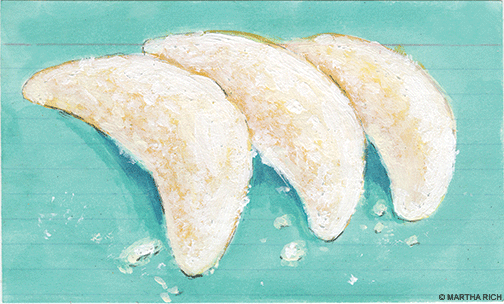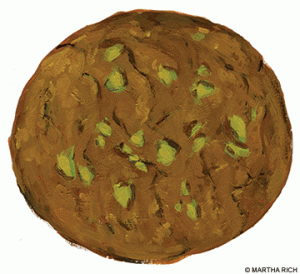
By Louisa Shafia | 1980. The Iranian hostage crisis was well under way, and the US military’s rescue attempt had failed, leaving eight American servicemen dead. My father, an Iranian-born doctor who had immigrated to the US 20 years earlier, was deeply ashamed, and let our family know that being Iranian was no source of pride. What’s more, the religious tensions between my father, a non-practicing Muslim, and my observant Ashkenazi Jewish mother, had reached a peak, filling our suburban Philadelphia home with the constant bickering of their personal holy war.
It was also the year that I lost Mrs. DuGan.
Mrs. D, as we called her, had been my caretaker and best friend since I was a few years old. She had answered our family’s ad in the newspaper for someone to care for my sister and me while my mother was busy running the family business.
A calm, loving presence in the storm of my family’s troubles—and source of invaluable amusement, with her penchant for exclamations like “What in the Sam Hell?!”—she quickly became a figure no less affectionate, engaged, and quirky than I would have wished of my own grandmothers, both of whom died before I knew them. From her carefully chosen Christmas presents to her multi-tiered Easter baskets—a welcome respite from our Judeo-Islamic standoff—Mrs. DuGan crafted and cooked like a storybook grandmother, with a deft touch, old-fashioned recipes, and meticulous kitchen habits that surely laid the groundwork for my own career in food.
When she died suddenly of heart failure at the age of 80, I was inconsolable. Not only had we lost Mrs. D, but—as is usually the case with hired “domestics”—also our connection to her world. After all, we weren’t blood relatives, were we? Although she had raised my sister and me as much as anyone had, she was our “nanny,” not our family. And after her funeral, our communication with Mrs. DuGan’s family simply stopped.
Three decades later, my own memory of Mrs. D had been largely relegated to some fading photos I kept on the mantle in my tiny Brooklyn apartment.
I had moved to New York shortly after college to pursue acting. When that pursuit peaked with a low-budget horror film, I decided to switch gears. I had always loved to cook, so I applied to culinary school, and found that I took to professional cooking like onions to a pan of hot grease. Not only did I find an outlet for my thwarted creativity, but in restaurant and catering kitchens I’d finally found a place where my perfectionist tendencies were a plus, even a requirement. Over time, I established a career made up of cookbook writing, restaurant consulting, recipe development, and teaching. I knew that food should be fresh and healthful, and that the food of my complex heritage was worth exploring.
But I would soon discover that my culinary influences were even broader than I thought.
One day when I was at home in Brooklyn with my husband, I received an excited call from my mom. “Guess what?” she said. “I was going through my files and I found Mrs. D’s recipe for Viennese Crescent cookies. It’s on an index card in her handwriting! I’m sending you a copy.”
My breath caught in my throat when I opened the envelope and saw the small, elegant cursive that had formed the words of so many birthday and holiday cards throughout my childhood.
I quickly got to work baking a batch of the curved, snow white cookies, with their coating of confectioner’s sugar and crumbly interior of ground almonds and butter. Licking the powdery dust from my fingers, the scent and taste of the cookies released a cache of vivid recollections, and a deep well of regret. It dawned on me that I didn’t even know where Mrs. DuGan’s grave was, her maiden name, or anything beyond my own personal experience with her. The taste had unlocked a memory: its joys, its pain, its limitations.
Time only made the need for answers more acute. When my second cookbook was released this past spring, I felt desperate to reconnect with Mrs. DuGan’s living memory, to thank her in some way for all her years of selfless generosity. After many nights of looking, I came across a familiar name several pages into a Google search: Ken DuGan, a resident of Bucks County, Pennsylvania, with a former address in Hatboro. Bingo! I recalled Mrs. DuGan’s many mentions of her hometown of “Hatburra.”
Nervously, I called his house. A man answered in a disarmingly friendly voice, saying he recognized my last name from the caller I.D.
“You’re from the family that Nana used to work for,” he said. “How are you?”
When I took the train a few weeks later to visit Ken and his wife, both retired schoolteachers, the connection was instant. At the station, a tall man with light hair and a gentle, eerily familiar smile walked up to me, and though we had only met once, at Mrs. DuGan’s funeral, some 33 years before, we shared a long, silent hug.
Back at his home, the three of us sat down to go through the photo albums that they had gathered for my visit. Although she was white-haired when I knew her, it turned out that Mrs. DuGan had been a redhead. She was born in 1899: Florence Elizabeth Fritsch DuGan. Her grandparents were immigrants from Dresden, Germany. She had never gone to college, and likely had not completed high school. She’d raised two sons and had four grandchildren, all before she became my caretaker. I was floored.
I was even more stunned when Ken told me that prior to coming to work for our family, Mrs. DuGan and her husband had, for decades, run the cafeteria at the long gone National Lead Company, in Philadelphia’s industrial Port Richmond neighborhood.
What do you know—Mrs. DuGan had been a professional cook, and, it turns out, one as deliberate and obsessive about her work methods as I am. The daily lunches she made me as a kid, though hardly exotic, were thoughtful affairs. I remember homemade chicken noodle and tomato soup, carefully constructed salami sandwiches made with mayonnaise, green leaf lettuce, and thinly sliced tomatoes. Her buttery, bakery-perfect Christmas cookies—especially the Viennese Crescents—were a highlight of the year, and her vanilla pound cake is still the best I’ve ever eaten. Just like grandma’s, you might say.
Mrs. DuGan’s history wasn’t all rosy. Her husband had been a heavy drinker and smoker in poor health, a dour man who had died of a heart attack while driving. In the passenger seat, she was hurt so badly that she couldn’t attend his funeral. Unable to return to work after convalescing, she eventually came to work for us, still needing to support herself into her 70s.
How little I knew. But Ken did confirm for me what I had known: that Mrs. D. was an especially kind person. She had been much adored by her family, not least of all by the children. I was indeed lucky to have had this woman in my life—and perhaps, through my childhood affection for her, now reaffirmed in adulthood, I had given her and her family some small but lasting happiness, too.
Ken sent me home with Mrs. D’s vintage metal potato masher, wooden tart tamper, and green porcelain teapot, all wrapped carefully in newspaper. And he admonished me to drop the “Mrs. D” and “just call her Nana.” Toward the end of our visit, he surprised me with a question.
“I hate to jump the gun, but are we going to see you again, either in Brooklyn or back here?”
I phoned my husband on the journey home, and told him, “We have some new family.”
Louisa Shafia C’92 is the author of The New Persian Kitchen and Lucid Food: Cooking for an Eco-Conscious Life.
This recipe is based on a traditional Persian tea cookie known as nan-e nokhodchi, or chickpea cookie, but in my version they get a buttery makeover that’s directly inspired by Mrs. DuGan’s classic Christmas cookies. I add almond flour because it makes the dough sturdier and mellows the distinct bean taste of the chickpea flour. The dough is rolled into a bar, chilled, then sliced and baked. Instead of colored sugar on top, they get a pinch of crushed pistachios. The bar of dough can be made ahead and chilled in the refrigerator for up to three days. Makes about 40 cookies.
 1/2 cup unsalted butter, at room temperature
1/2 cup unsalted butter, at room temperature
1/2 cup organic cane sugar
1 teaspoon rose water
1/2 cup plus 3 tablespoons chickpea flour
1/2 cup plus 3 tablespoons almond flour
1 teaspoon ground cardamom
1/2 teaspoon ground cinnamon
1/4 teaspoon sea salt
3 tablespoons pistachios, coarsely ground
Cream together the butter and sugar with an electric mixer. Beat in the rose water for a few seconds. Whisk together the flours, cardamom, cinnamon, and salt in a separate bowl, and beat into the butter in two batches, until just combined. Turn the dough out onto a piece of plastic wrap and press it into a disk. Wrap and chill in the freezer for 30 minutes.
Remove the dough from the freezer, unwrap it, and lay it in the middle of a large piece of plastic wrap or wax paper. Fold the wrap or paper over the dough. Form the dough into a log approximately 10 inches in length and 1 1/2 inches in diameter, then square off the long sides to form a bar. Chill in the refrigerator until the dough is very firm, at least 2 hours.
Preheat the oven to 350°F. Line two baking sheets with parchment paper. Slice the bar into cookies 1/4 inch thick and place them on the prepared baking sheets, 1 inch apart. Press a pinch of pistachios into each cookie.
Bake the cookies until the bottoms are just golden, 15 to 18 minutes. Let cool on the pans for 5 minutes, then transfer to cooling racks. The cookies can be stored in a sealed container at room temperature for up to 5 days.

